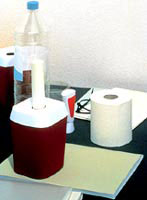Demand drafts
German artist Thomas Demand reproduces archive images out of paper and cardboard then re-photographs them.

Thomas Demand is a very successful German artist-photographer in his mid-thirties whose work has been exhibited widely in Europe and the US over the past decade. What makes him unique is the way he challenges the viewer’s perception. His pictures are not what they appear. In an interesting and decidedly cyber-free take on virtual reality, Demand replicates images in 3D and photographs them as if they were the original image.
Did you get that? No, neither did I at first. In plain English, he takes an archive picture, usually something inanimate, like a room or a building, painstakingly recreates it out of cardboard and paper, down to the tiniest detail, lights it appropriately, then takes a large-scale colour photograph of this mock-up. Judging by the international demand for Demand – he seems to have exhibited in every leading gallery in Europe and the US – this is a process that has caught the imaginations of many.
His source material comprises things such as his old school staircase, Bill Gates’s college desk, the film archive of Leni Riefenstahl, the corridor leading to the apartment of mass murderer Jeffrey Dahmer, and the hotel room where L Ron Hubbard wrote his Scientology manifesto. “I try to redo a photograph in a way that is free of the connotations of where it has been,” says Demand. “I think photography is less about representing than constructing its objects.”
His oeuvre is coming to the newly relocated Victoria Miro Gallery in London’s Shoreditch later this month. A big fan of his work – this is the third solo show she’s mounted – Miro actually enlisted his help in converting a Grade II listed Victorian furniture factory into her bright new gallery space. Though he lives and works in Berlin, Demand studied fine arts here at Goldsmith’s College and feels very much at home in London, thanks largely to the patronage of Miro.
His reputation has grown steadily over the past decade, and he is now represented in such esteemed collections as the Tate, the Guggenheim, the Museum of Modern Art, and the Saatchi. Conceptual art always attracts a lot of impenetrable waffle and humbug from commentators, and sometimes from the artists themselves. You cannot help wondering if the hype factor isn’t as crucial to the success of someone like Demand as any talent or originality.
In an attempt to extract some commonsense answers from the great man, I e-mailed a few pertinent questions to Berlin. The exchange went like this:
NS: Anyone looking at your work who knew nothing about it would assume they were just straightforward photographs of whatever they appear to represent. Why is the fact that they’re not what they appear to represent significant to anyone other than you?
TD: I cannot say anything about other people’s interests, I’m afraid. But why are you curious?
NS: Did you invent this form or was it already established when you came to it?
TD: I invented it from sculpture, and it seems to be so successful that lots of my colleagues do it now, too. I take that as a compliment.
NS: Is it art or photography, or both?
TD: I don’t understand the question. It’s like saying “Is it bright or is it blue?”
NS: Wouldn’t it be more interesting to see your constructions as well?
TD: You want to learn more about the relation between an object and what it looks like being photographed?
NS: How much further can you go with it? Do you intend moving on to something else?
TD: I am doing different things every day, as you do. Do you know how much further you can go with your way of writing?
NS: You say that your aim is to produce one particular moment of perfection. Isn’t that the aim of all photography?
TD: No. Have a look at Richard Billingham, at Nan Goldin, or have a look into the Evening Standard and its images (ie journalistic photography), or even have a look at X-ray photography. Or did you mean perfection in terms of proper use of the technique? Well then, every photographer is aiming for perfection, but I said a particular moment of perfection. Maybe that is what we should talk about.
Thomas Demand’s work will be on display at the new Victoria Miro Gallery, Wharf Road, London N1, from 26 November
-
Post a comment




